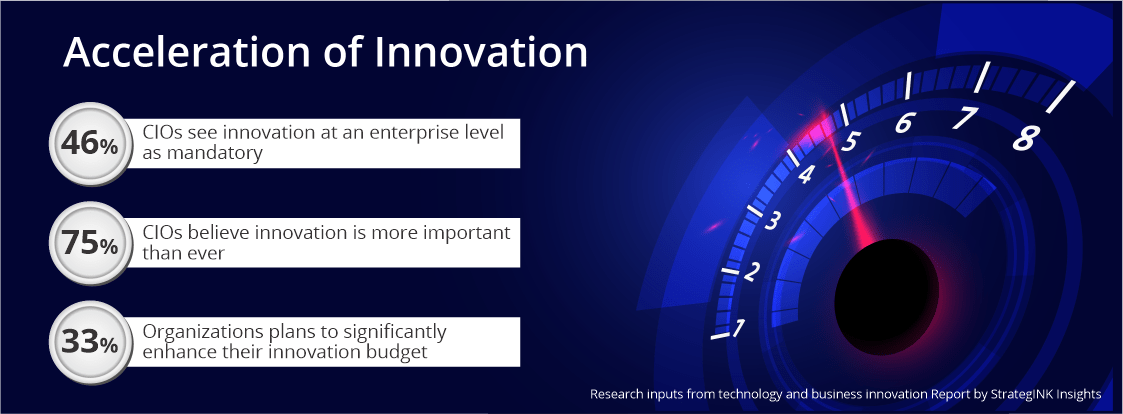
Explore how the Future of Work will prioritize innovation and promote a shift to a hybrid workplace, leading to an adoption of automation and acceleration to meet the dynamic market conditions.
Future of Work (FoW) has been a buzzword for organizations globally. As the term suggests, Future of Work aims to capture and explain the various trends that are likely to impact work in all its aspects. According to a study by Deloitte, Future of Work encompasses changes in the work, the workforce and the workplace. Before the unleashing of the pandemic, most organizations viewed FoW as a move towards remote work, automation, among others. With Covid-19 in the picture, the understanding of what accounts as the Future of Work has undergone serious reconsideration.
While there has been an acceleration in the adoption of some previous ideas like adoption of artificial intelligence and other technological drivers, shift to hybrid models of working, etc., some new trends have also emerged in the past year. This will be a three part series, through which we will unveil the 9 key trends that are likely to define the Future of Work in the new normal. The seven trends we have identified draw evidence from a research conducted by StrategINK insights with 326 CXO leaders. These trends are a reflection of the changing customer and employee expectations, dynamic market conditions and shifting organizational priorities.
Urgency and acceleration of business innovation

Innovation had been a priority for many organizations, at varying degrees, before Covid-19 came along. However, with the global spread of the pandemic, the urgency and immediacy to innovate increased exponentially. This is evidently reflected in the first trend redefining the FoW, an accelerated approach to innovation. According to our research, “46% of the respondents believe that the pandemic has unleashed an existential crisis for organizations at innovation at an enterprise level has become mandatory.” At the same time, “Over 75% of the respondents believe that innovation is more important now than ever before with the background of the pandemic.” The changing market dynamics have prompted organizations to speed up their innovation efforts.

Increasingly, organizations are likely to have aggressive timelines and increased budget allocations for innovation. Amongst the respondents of our study, “1 in 3 organizations plan to significantly enhance their investments to create value for innovation as a business strategy.” At the same time, organizations will be motivated to adopt an enterprise-wide approach to innovation, as opposed to the conventional siloed one. Our research shows that, “47% of the respondents see innovation as a strategic and enterprise-wide investment which is expected to yield impact in a multi-year horizon and 55% of the respondents will adopt a holistic approach to innovation with a convergence of human and technology capital.” Therefore, enterprise-wide innovation is imperative in the new normal to not only survive, but thrive and grow.
Shift to a hybrid workplace

At the start of the pandemic, remote work was seen as a temporary measure, till the dust settled. However, over a year of working virtually, organizations and business leaders believe that a hybrid workplace, combining the physical and virtual will define FoW in the new normal. According to a survey by Growmotely, “74% of professionals expect remote work to become standard.” This clearly indicates a shifting of employee expectations in favor of virtual workplaces, connecting digitally, practically reshaping where work is done. While the intensity of remote work might reduce as compared to when the pandemic started, FoW is likely to be flexible, remote and virtual.
Organizations need to adopt long-term measures and practices to rethink the whole notion of physical proximity and work. To smoothly transition into a hybrid model of work, business leaders need to focus on different aspects of the organizations. To begin with, organizations must craft a hybrid work policy that indicates the shift and what exactly the hybrid model of work entails. At the same time, they must invest in technological tools and advancements that make collaboration and communication seamless with the virtual workforce. Finally, organizations need to have leadership alignment on which parts of the business require in-person interaction like critical decisions, etc. and have a clear clarity on the hybrid model.
Greater adoption of automation and artificial intelligence
Increased investments in technology upgradation and building tech capabilities will definitely define FoW in the post pandemic world. As a hybrid model of work becomes the norm, roles that require on-premise presence are likely to undergo automation and there will be an increased adoption of artificial intelligence. According to our research, AI/ML and automation are two amongst the top 5 technology drivers that organizations are likely to adopt in the new normal to redefine the way they work as well as accelerate their innovation journey. 54% of the respondents believe that AI/ML as a service will be a major priority in the post-pandemic business redefinition and 48% see automation as another priority that will reinvent business processes.

Increasingly the balance between jobs held by humans and machines is likely to be dynamic with more and more repetitive tasks being allocated to machines. This will further increase in the post-pandemic age where tasks requiring manual and physical proximity will move to the machines. However, contrary to popular belief, human jobs will not be lost, but will just be replaced by tasks requiring critical human skills like problem solving, communication which are data-driven and can accentuate and add value to the machine-driven work. At the same time, the pandemic has witnessed a great influx of data from all across. AI/ML will unleash the power of this data to enable innovation leaders to adopt a strategic approach to innovation with evidence-based and agile decision making in uncertain and ambiguous times. Therefore, the adoption of automation and AI/ML is likely to increase exponentially, pushing businesses to realign their technology priorities to thrive in a digital-first world.
Essential Guidance for IT Leaders

IT leaders must adopt a strategic approach if they wish to survive and thrive as the pandemic redefines the Future of Work. A key area of focus must be on accelerating the innovation journey by enhancing budgets to ensure business continuity. Here, IT leaders must invest both in technology and human capital. At the same time, identifying top technological drivers based on industry benchmarks must be explored and adopted to succeed in a digital-first economy. This will include adoption of hybrid workspaces, increase in remote work and collaborations, amongst others. CIOs and other IT leaders must prepare their infrastructure and human capital in a way that best utilizes these advances in the nature and scope of work. The bottom line here is that it’s time IT leaders acknowledge the urgency of innovation and technological disruption and start with investing in the right technologies (AI/ML/Automation), infrastructure (hybrid workspaces) and stepping up their human capital.
Stay tuned for the next part which will focus on how the new normal will impact the workforce, creating new avenues to redefine FoW!




